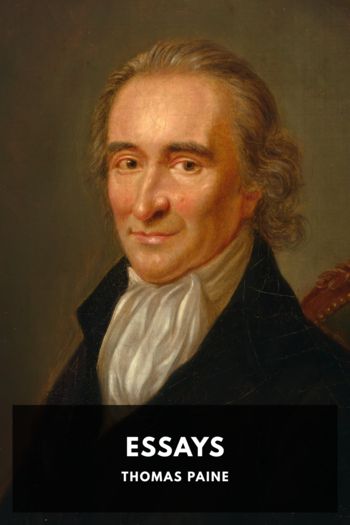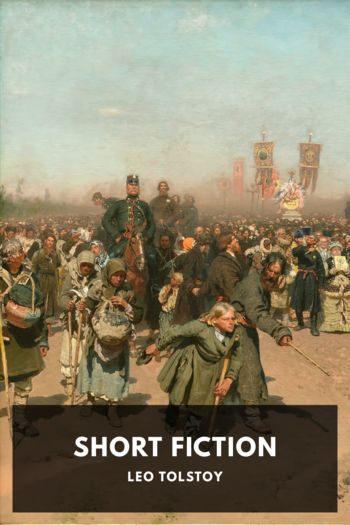The Age of Reason by Thomas Paine (icecream ebook reader TXT) 📕

- Author: Thomas Paine
Book online «The Age of Reason by Thomas Paine (icecream ebook reader TXT) 📕». Author Thomas Paine
The story of Jesus Christ appearing after he was dead is the story of an apparition, such as timid imaginations can always create in vision, and credulity believe. Stories of this kind had been told of the assassination of Julius Caesar not many years before, and they generally have their origin in violent deaths, or in execution of innocent persons. In cases of this kind, compassion lends its aid, and benevolently stretches the story. It goes on a little and a little farther, till it becomes a most certain truth. Once start a ghost, and credulity fills up the history of its life, and assigns the cause of its appearance; one tells it one way, another another way, till there are as many stories about the ghost, and about the proprietor of the ghost, as there are about Jesus Christ in these four books.
The story of the appearance of Jesus Christ is told with that strange mixture of the natural and impossible, that distinguishes legendary tale from fact. He is represented as suddenly coming in and going out when the doors are shut, and of vanishing out of sight, and appearing again, as one would conceive of an unsubstantial vision; then again he is hungry, sits down to meat, and eats his supper. But as those who tell stories of this kind never provide for all the cases, so it is here: they have told us, that when he arose he left his grave-clothes behind him; but they have forgotten to provide other clothes for him to appear in afterwards, or to tell us what he did with them when he ascended; whether he stripped all off, or went up clothes and all. In the case of Elijah, they have been careful enough to make him throw down his mantle; how it happened not to be burnt in the chariot of fire, they also have not told us; but as imagination supplies all deficiencies of this kind, we may suppose if we please that it was made of salamander’s wool.
Those who are not much acquainted with ecclesiastical history, may suppose that the book called the New Testament has existed ever since the time of Jesus Christ, as they suppose that the books ascribed to Moses have existed ever since the time of Moses. But the fact is historically otherwise; there was no such book as the New Testament till more than three hundred years after the time that Christ is said to have lived.
At what time the books ascribed to Matthew, Mark, Luke and John, began to appear, is altogether a matter of uncertainty. There is not the least shadow of evidence of who the persons were that wrote them, nor at what time they were written; and they might as well have been called by the names of any of the other supposed apostles as by the names they are now called. The originals are not in the possession of any Christian Church existing, any more than the two tables of stone written on, they pretend, by the finger of God, upon Mount Sinai, and given to Moses, are in the possession of the Jews. And even if they were, there is no possibility of proving the handwriting in either case. At the time those four books were written there was no printing, and consequently there could be no publication otherwise than by written copies, which any man might make or alter at pleasure, and call them originals. Can we suppose it is consistent with the wisdom of the Almighty to commit himself and his will to man upon such precarious means as these; or that it is consistent we should pin our faith upon such uncertainties? We cannot make nor alter, nor even imitate, so much as one blade of grass that he has made, and yet we can make or alter words of God as easily as words of man.75
About three hundred and fifty years after the time that Christ is said to have lived, several writings of the kind I am speaking of were scattered in the hands of diverse individuals; and as the church had begun to form itself into an hierarchy, or church government, with temporal powers, it set itself about collecting them into a code, as we now see them, called “The New Testament.” They decided by vote, as I have before said in the former part of The Age of Reason, which of those writings, out of the collection they had made, should be the word of God, and which should not. The Robbins of the Jews had decided, by vote, upon the books of the Bible before.
As the object of the church, as is the case in all national establishments of churches, was power and revenue, and terror the means it used, it is consistent to suppose that the most miraculous and wonderful of the writings they had collected stood the best chance of being voted. And as to the authenticity of the books, the vote stands in the place of it; for it can be traced no higher.
Disputes, however, ran high among the people then calling themselves Christians, not only as to points of doctrine, but as to the authenticity of the books. In the contest between the person called St. Augustine, and Fauste, about the year 400, the latter says, “The books called the Evangelists have been composed long after the times of the apostles, by some obscure men, who, fearing that the world would not give credit to their relation of matters of which they could not be informed, have published them under the names of the apostles; and which are so full of sottishness and discordant relations, that there is neither agreement nor connection between them.”
And in another place, addressing himself to the advocates of those books, as being the word of





Comments (0)